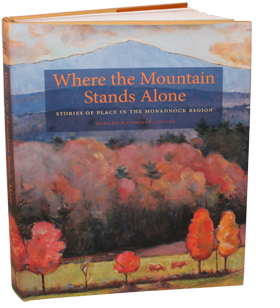WHERE THE MOUNTAIN STANDS ALONE:
STORIES OF PLACE IN THE MONADNOCK REGION
UPNE
Where the Mountain Stands Alone ranges from the formation of the region’s distinctive landscape to the lives and customs of its first inhabitants, from the industrialization of the early 19th Century to the collapse of both farms and mills, from the region’s influence on writers and artists to the rewilding and repopulating of the twentieth century. It is a selective but richly suggestive overview of centuries of human interaction with a particular landscape. “That New Hampshire bluff,” as Henry David Thoreau said of Monadnock, “will longest haunt our dreams.”
Featuring contributions from such writers as Sy Montgomery, Ernest Hebert, Janisse Ray, Tom Wessels, Richard Ober, Jim Collins, and Jane Brox.
The Monadnock Institute of Nature, Place and Culture at Franklin Pierce College in Rindge, New Hampshire, promotes the interdisciplinary study of place and of the connections between community and environment.
“[An] evocative collection of essays.”
— The Boston Globe
“A rich collection of stories, essays, images, and historical texts that paint the multidimensional landscape of New Hampshire’s Monadnock region. This anthology testifies to the way in which natural and human history together create a distinct sense of place.”
— Orion Magazine
“A remarkable thing about this particularly well-written and strikingly illustrated collection of 50-plus articles and personal remembrances is that, unlike the mountain that gives it is name, the book itself does not stand alone; it’s part of a process that includes workshops, academic studies and a constantly expanding Web-based collection of additional stories about the region and its people.”
— The Keene Sentinel
“Howard Mansfield, who edited this collection of “stories of place in the Monadnock region,” writes beautifully himself. He selected top-notch work from writers at their peaks for this softcover coffee-table book, sumptuously illustrated with photographs, paintings, etchings, and line drawings by Guillermo Nunez. Mansfield, the historian, shows his expertise and control not only in his detailed introduction and prefaces to each section, but also in surprising complementary material labeled “Readings” or “Recollections”: excerpts from town reports and town histories, quotes from newspapers and magazines dating to the 1800s, journal and diary entries, a deed from 1866, a letter to the editor from 1946, personal letters. This is a full and varied volume, inviting readers to spend―as I did― many hours, not reading cover to cover; but a little of this and a little of that.”
— The Concord Monitor

